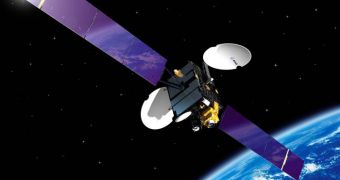On February 15, the European Space Agency is scheduled to launch its second ATV to the International Space Station (ISS). During the flight, the Artemis data relay satellite will play a critical role in facilitating communications with the spacecraft.
The satellite's role is to connect the Johannes Kepler resupply capsule with the ATV Control Center (ATV-CC), in Toulouse, France. The unmanned cargo ship is due to deliver a host of supplies to the Expedition 26 crew aboard the space lab.
It is due to launch on February 15 from the Kourou Spaceport, in the French Guyana, aboard an Ariane 5 heavy-lift delivery system. It is the second Automated Transfer Vehicle (ATV) built and launched by ESA, and it joins an international fleet of similar spacecraft.
As the US space shuttles are planned to retire this year, their duties will need to be taken on by ESA's ATV, the Japanese H-II Transfer Vehicles (HTV), and the Russian Progress capsules. Astronauts will only get to the ISS aboard Russian-built Soyuz space capsules.
As such, ensuring that each of the ATV reaches its destination successfully is a major priority for the European Space Agency. Even if Johannes Kepler has its own communication systems, its contact will also be facilitated by Artemis.
The relay spacecraft is located in a geostationary orbit at 21.4ºE, at an altitude of about 36,000 kilometers. It will route commands and telemetry data every time the ISS or the ATV come into view.
The Artemis mission is being controlled from the ESA Redu site, in Belgium. The 13.5 m-diameter dish antenna that sends and receives commands from the spacecrafts is ties to a Ka-band ground terminal, that routes signals to the control center.
In addition to the ESA satellite, Johannes Kepler will also be tracked using the NASA Tracking and Data Relay Satellite System (TDRSS) constellation.
“Artemis will again provide dedicated support to ATV throughout the free-flying phase of its mission up to the docking with the Station. TDRSS is the backup to Artemis during the attached phase, while Artemis will back up TDRSS during the other phases and in emergency situations,” reads an ESA press release.
“As Artemis also provides support to ESA’s Envisat’s Earth observation satellite, the Mission Control Center ensures there will be no conflicts between the two satellites,” says Benoit Demelenne.
“The experience gained during the ATV-1 mission has been fruitful in preparing us for this mission,” explains the ESA official, who is the head of the Spacecraft Operations Unit at Redu.

 14 DAY TRIAL //
14 DAY TRIAL //